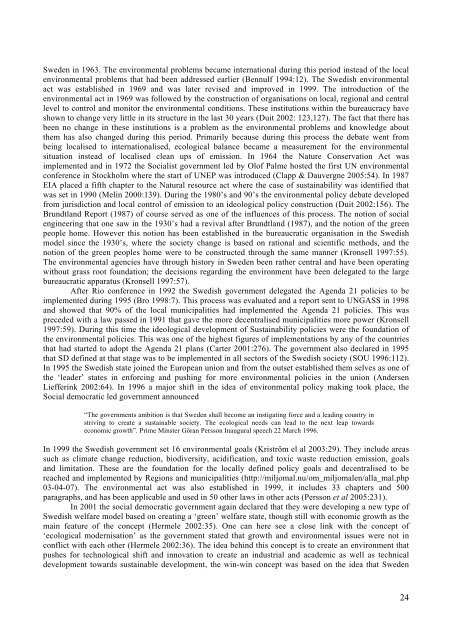From 'grey to green'- investigating the capabilities of the ... - lumes
From 'grey to green'- investigating the capabilities of the ... - lumes
From 'grey to green'- investigating the capabilities of the ... - lumes
Create successful ePaper yourself
Turn your PDF publications into a flip-book with our unique Google optimized e-Paper software.
Sweden in 1963. The environmental problems became international during this period instead <strong>of</strong> <strong>the</strong> localenvironmental problems that had been addressed earlier (Bennulf 1994:12). The Swedish environmentalact was established in 1969 and was later revised and improved in 1999. The introduction <strong>of</strong> <strong>the</strong>environmental act in 1969 was followed by <strong>the</strong> construction <strong>of</strong> organisations on local, regional and centrallevel <strong>to</strong> control and moni<strong>to</strong>r <strong>the</strong> environmental conditions. These institutions within <strong>the</strong> bureaucracy haveshown <strong>to</strong> change very little in its structure in <strong>the</strong> last 30 years (Duit 2002: 123,127). The fact that <strong>the</strong>re hasbeen no change in <strong>the</strong>se institutions is a problem as <strong>the</strong> environmental problems and knowledge about<strong>the</strong>m has also changed during this period. Primarily because during this process <strong>the</strong> debate went frombeing localised <strong>to</strong> internationalised, ecological balance became a measurement for <strong>the</strong> environmentalsituation instead <strong>of</strong> localised clean ups <strong>of</strong> emission. In 1964 <strong>the</strong> Nature Conservation Act wasimplemented and in 1972 <strong>the</strong> Socialist government led by Ol<strong>of</strong> Palme hosted <strong>the</strong> first UN environmentalconference in S<strong>to</strong>ckholm where <strong>the</strong> start <strong>of</strong> UNEP was introduced (Clapp & Dauvergne 2005:54). In 1987EIA placed a fifth chapter <strong>to</strong> <strong>the</strong> Natural resource act where <strong>the</strong> case <strong>of</strong> sustainability was identified thatwas set in 1990 (Melin 2000:139). During <strong>the</strong> 1980’s and 90’s <strong>the</strong> environmental policy debate developedfrom jurisdiction and local control <strong>of</strong> emission <strong>to</strong> an ideological policy construction (Duit 2002:156). TheBrundtland Report (1987) <strong>of</strong> course served as one <strong>of</strong> <strong>the</strong> influences <strong>of</strong> this process. The notion <strong>of</strong> socialengineering that one saw in <strong>the</strong> 1930’s had a revival after Brundtland (1987), and <strong>the</strong> notion <strong>of</strong> <strong>the</strong> greenpeople home. However this notion has been established in <strong>the</strong> bureaucratic organisation in <strong>the</strong> Swedishmodel since <strong>the</strong> 1930’s, where <strong>the</strong> society change is based on rational and scientific methods, and <strong>the</strong>notion <strong>of</strong> <strong>the</strong> green peoples home were <strong>to</strong> be constructed through <strong>the</strong> same manner (Kronsell 1997:55).The environmental agencies have through his<strong>to</strong>ry in Sweden been ra<strong>the</strong>r central and have been operatingwithout grass root foundation; <strong>the</strong> decisions regarding <strong>the</strong> environment have been delegated <strong>to</strong> <strong>the</strong> largebureaucratic apparatus (Kronsell 1997:57).After Rio conference in 1992 <strong>the</strong> Swedish government delegated <strong>the</strong> Agenda 21 policies <strong>to</strong> beimplemented during 1995 (Bro 1998:7). This process was evaluated and a report sent <strong>to</strong> UNGASS in 1998and showed that 90% <strong>of</strong> <strong>the</strong> local municipalities had implemented <strong>the</strong> Agenda 21 policies. This waspreceded with a law passed in 1991 that gave <strong>the</strong> more decentralised municipalities more power (Kronsell1997:59). During this time <strong>the</strong> ideological development <strong>of</strong> Sustainability policies were <strong>the</strong> foundation <strong>of</strong><strong>the</strong> environmental policies. This was one <strong>of</strong> <strong>the</strong> highest figures <strong>of</strong> implementations by any <strong>of</strong> <strong>the</strong> countriesthat had started <strong>to</strong> adopt <strong>the</strong> Agenda 21 plans (Carter 2001:276). The government also declared in 1995that SD defined at that stage was <strong>to</strong> be implemented in all sec<strong>to</strong>rs <strong>of</strong> <strong>the</strong> Swedish society (SOU 1996:112).In 1995 <strong>the</strong> Swedish state joined <strong>the</strong> European union and from <strong>the</strong> outset established <strong>the</strong>m selves as one <strong>of</strong><strong>the</strong> ‘leader’ states in enforcing and pushing for more environmental policies in <strong>the</strong> union (AndersenLiefferink 2002:64). In 1996 a major shift in <strong>the</strong> idea <strong>of</strong> environmental policy making <strong>to</strong>ok place, <strong>the</strong>Social democratic led government announced“The governments ambition is that Sweden shall become an instigating force and a leading country instriving <strong>to</strong> create a sustainable society. The ecological needs can lead <strong>to</strong> <strong>the</strong> next leap <strong>to</strong>wardseconomic growth”. Prime Minster Göran Persson Inaugural speech 22 March 1996.In 1999 <strong>the</strong> Swedish government set 16 environmental goals (Kriström el al 2003:29). They include areassuch as climate change reduction, biodiversity, acidification, and <strong>to</strong>xic waste reduction emission, goalsand limitation. These are <strong>the</strong> foundation for <strong>the</strong> locally defined policy goals and decentralised <strong>to</strong> bereached and implemented by Regions and municipalities (http://miljomal.nu/om_miljomalen/alla_mal.php03-04-07). The environmental act was also established in 1999, it includes 33 chapters and 500paragraphs, and has been applicable and used in 50 o<strong>the</strong>r laws in o<strong>the</strong>r acts (Persson et al 2005:231).In 2001 <strong>the</strong> social democratic government again declared that <strong>the</strong>y were developing a new type <strong>of</strong>Swedish welfare model based on creating a ‘green’ welfare state, though still with economic growth as <strong>the</strong>main feature <strong>of</strong> <strong>the</strong> concept (Hermele 2002:35). One can here see a close link with <strong>the</strong> concept <strong>of</strong>‘ecological modernisation’ as <strong>the</strong> government stated that growth and environmental issues were not inconflict with each o<strong>the</strong>r (Hermele 2002:36). The idea behind this concept is <strong>to</strong> create an environment thatpushes for technological shift and innovation <strong>to</strong> create an industrial and academic as well as technicaldevelopment <strong>to</strong>wards sustainable development, <strong>the</strong> win-win concept was based on <strong>the</strong> idea that Sweden24
















